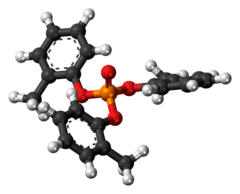Tricresyl phosphate
 | |
 | |
| Names | |
|---|---|
| Other names
tricresylphosphate, tri-o-cresyl phosphate, TOCP, tritolyl phosphate, tolyl phosphate, tri-o-tolyl ester of phosphoric acid | |
| Identifiers | |
| 1330-78-5 | |
| ChemSpider | 21106216 |
| Jmol interactive 3D | Image |
| |
| |
| Properties | |
| C21H21O4P | |
| Molar mass | 368.37 g/mole |
| Appearance | colourless liquid |
| Melting point | −40 °C (−40 °F; 233 K) |
| Boiling point | 255 °C (491 °F; 528 K) (10 mmHg) |
| Hazards | |
| Flash point | > 225 °C (437 °F; 498 K) |
| Except where otherwise noted, data are given for materials in their standard state (at 25 °C [77 °F], 100 kPa). | |
| | |
| Infobox references | |
Tricresyl phosphate, abbreviated TCP, is an organophosphate compound that is used as a plasticizer and diverse other applications. It is a colourless, viscous liquid, although commercial samples are typically yellow. It is virtually insoluble in water.
Production
Tricresyl phosphate is manufactured by reaction of cresols with phosphorus oxychloride:
- OPCl3 + 3 HOC6H4CH3 → OP(OC6H4CH3)3 + 3 HCl
The cresol is a mixture of three isomers (ortho, meta, and para). The fact that tricresyl phosphate is derived from a mixture and itself is a mixture ensures that it remains liquid over a wide span of temperatures.
Chemical reactions
In alkaline medium it undergoes hydrolysis to cresol and dicresyl phosphate.
- OP(OC6H4CH3)3 + NaOH → + HOC6H4CH3 + NaO2P(OC6H4CH3)2
In the body, it is metabolized in part by hydroxylation to give a catecholate derivative, which is the bio-active agent responsible for the neurotoxicity.[1]
Uses
Tricresyl phosphate is used as a plasticizer in nitrocellulose, acrylate lacquers, varnishes, and in polyvinyl chloride. It is a flame retardant in plastics and rubbers. It is used as a gasoline additive as a lead scavenger for tetraethyllead.[2] It is a hydraulic fluid and a heat exchange medium. Exploiting its hydrophobic properties, it is used for the waterproofing of materials. It is a solvent for extractions, a solvent for nitrocellulose and other polymers. It is used as an antiwear and extreme pressure additive in lubricants and hydraulic fluids.[1][3]
Safety
TCP is the cause of numerous poisonings and is a neurotoxin, in part via organophosphate-induced delayed neuropathy.[4] It is of “toxicological importance” and has been responsible for many deaths. One of the most serious incidents occurred in the 1920s when TCP was an adulterant for Jamaica ginger.[1] Another occurred in Morocco, in 1959, when cooking oil was adulterated with jet engine lubricant containing TCP.[5]
TCP's initial mechanism of action is similar to that of certain other organophosphates in that it can inhibit the enzyme acetylcholinesterase, leading to a buildup of acetylcholine in the synaptic space. This can lead to hyperactivity in cholinergic neurons in the brain and at neuromuscular junctions in the peripheral nervous system resulting in apoptosis of those cell-types.
TCP is used as an additive in turbine engine oil and can potentially get into the airliner cabins via a bleed air "fume event". Aerotoxic syndrome is the name given to the alleged health ill-effects (with symptoms including memory loss, depression and schizophrenia) caused by exposure to engine chemicals although UK industry-funded studies have not yet made a link between TCP and long-term health issues.[6] The most dangerous isomers are considered to be those containing ortho isomers, such as tri-ortho-cresyl phosphate, TOCP. The World Health Organisation stated in 1990 that "Because of considerable variation among individuals in sensitivity to TOCP, it is not possible to establish a safe level of exposure" and "TOCP are therefore considered major hazards to human health."[7] Therefore, strenuous efforts have been made to reduce the content of the ortho isomers in commercial TCP if there is a risk of human exposure. Nevertheless, actual measurements of TOCP concentrations in airliner cabin air show a much higher level than expected.[8] Researchers at the University of Washington found that non-ortho TCP isomers present in synthetic jet engine oils do inhibit certain enzymes.[9]
TCP is combustible, although less so than typical organic compounds.
References
- 1 2 3 Jürgen Svara, Norbert Weferling, Thomas Hofmann "Phosphorus Compounds, Organic" in Ullmann's Encyclopedia of Industrial Chemistry 2006, Wiley-VCH: Wienheim. doi:10.1002/14356007.a19_545.pub2
- ↑ Marvel & other solutions to the lead problem, checked 2009-06-18.
- ↑ Solbu, K.; Thorud, S.; Hersson, M.; Ovrebø, S.; Ellingsen, G.; Lundanes, E.; Molander, P. (Aug 2007). "Determination of airborne trialkyl and triaryl organophosphates originating from hydraulic fluids by gas chromatography-mass spectrometry. Development of methodology for combined aerosol and vapor sampling". Journal of Chromatography A 1161 (1–2): 275–283. doi:10.1016/j.chroma.2007.05.087. ISSN 0021-9673. PMID 17574560.
- ↑ Lack of Delayed Neurotoxic Effect after Tri-o-cresyl Phosphate Treatment in Male Fischer 344 Rats: Biochemical, Neurobehavioral and Neuropathological Studies
- ↑ Segalla, S. (2011). "The 1959 Moroccan Oil Poisoning and US Cold War Disaster Diplomacy." Journal of North African Studies. Available online at doi:10.1080/13629387.2011.610118
- ↑ UK Parliament: Elements of healthy cabin air
- ↑ Tricresyl Phosphate Environmental Health Criteria A110. International Programme On Chemical Safety (IPCS) WHO Geneva 1990
- ↑ J.J. Ramsden (2013). "On the proportion of ortho isomers in the tricresyl phosphates contained in jet oil". Journal of Biological Physics and Chemistry 13 (2): 69–72. doi:10.4024/03RA13L.jbpc.13.02.
- ↑ Baker P., Cole T et al., Identifying safer anti-wear triaryl phosphate additives for jet engine lubricants. Chemico-Biological Interactions. Volume 203, Issue 1, 25 March 2013, Pages 257–264